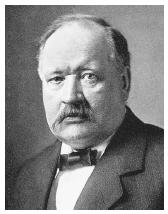Svante Arrhenius

COFOUNDER OF MODERN PHYSICAL CHEMISTRY
1859–1927
Svante August Arrhenius, born in Vik, Sweden, is regarded as the cofounder of modern physical chemistry. For his theory of electrolytic dissociation, Arrhenius received the Nobel Prize in chemistry in 1903. He also made important contributions to chemical kinetics and many other branches of science.
In 1884 Arrhenius obtained his Ph.D. from the University of Uppsala with a thesis on the conductivities of electrolytic solutions. Although poorly rated by his examiners, his thesis attracted the attention of the most distinguished physicists and physical chemists in Europe at the time. Arrhenius collaborated with a number of them from 1886 until 1890. Based on his international reputation, he secured a post at the Technical High School in Stockholm, first as a lecturer, then as a professor, and finally as its rector. He later became director of the new physical chemistry institute of the Nobel Foundation in 1905. By that time, his interests had already shifted toward other fields of science.
Arrhenius is mainly known for his equation describing the temperature dependence of chemical reaction rates:
k = A exp(− E / RT )
with k being the reaction rate constant, A a preexponential factor, E the activation energy, R the gas constant, and T the absolute temperature. Although the equation was first formulated by Dutch physical chemist Jacobus Hendricus van't Hoff in 1884, Arrhenius provided the interpretation of it that is still in use today. He suggested that the crucial step in a chemical reaction was the formation of activated molecules from the reactant molecules and that both states were in equilibrium , separated from each other by the activation energy E. Accordingly, he explained the temperature dependence of the reaction rate as a change of equilibrium, such that with increasing temperature more activated molecules were formed to undergo reaction. Furthermore, plotting the experimental results of ln k against 1/ T (the so-called Arrhenius plot) yielded in many cases a straight line, from the slope of which one could easily calculate the activation energy E.
Arrhenius's most famous contribution, making him with the German physical chemist Friedrich Wilhelm Ostwald and van't Hoff a cofounder of modern physical chemistry, was his theory of electrolytic dissociation. Electrolytes are substances such as salts, acids, and bases that conduct electric current in solutions. Arrhenius suggested that every electrolyte, once dissolved in a solvent like water, dissociated into oppositely charged ions to a certain degree that depended on its nature and overall concentration. Before this explanation, chemists had continued to believe that electrolytes dissolved as uncharged molecules that could be separated only by strong electric forces, such as in electrolysis. Although the forces for electrolytic dissociation remained unclear for some time, Arrhenius's assumption could explain a wide range of phenomena and laws beyond electrochemistry. This included Raoult's laws of vapor pressure lowering and freezing point depression, Ostwald's dilution law, and van't Hoff's law of osmotic pressure of solutions. As Ostwald later showed in his acid-base theory, it also provided a quantitative understanding of the chemical activities of electrolytes in solution.
In his later years, Arrhenius applied the concepts of physical chemistry and physics to many other branches of science, including biochemistry, geoand cosmic physics, and meteorology. In retrospect, his most remarkable contribution was perhaps his model of the greenhouse effect , according to which the temperature of Earth's lower atmosphere is determined by the concentration of carbon dioxide. Earth's surface, after being warmed by sunlight, emits energy in the form of infrared radiation, which is absorbed by molecules in the atmosphere, particularly carbon dioxide; the absorption of infrared radiation leads to heat. At that time, the greenhouse effect model was used to explain the glacial periods, rather than any climatic changes induced by the human production of carbon dioxide, as is the case today.
SEE ALSO Global Warming ; Ostwald, Friedrich Wilhelm ; VAN'T Hoff, Jacobus .
Joachim Schummer
Bibliography
Crawford, Elisabeth (1996). Arrhenius. From Ionic Theory to the Greenhouse Effect. Canton, MA: Science History Publications.
Snelders, H. A. M. (1970). "Arrhenius, Svante August." In Dictionary of Scientific Biography , Vol. I, ed. Charles C. Gillispie. New York: Scribner.
Comment about this article, ask questions, or add new information about this topic: